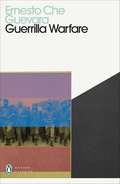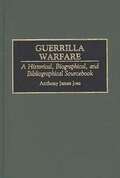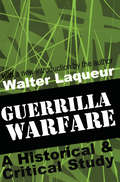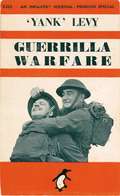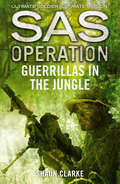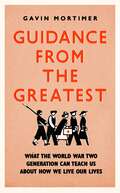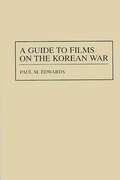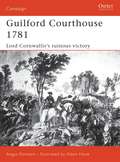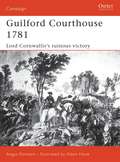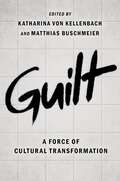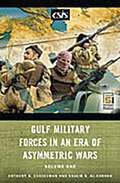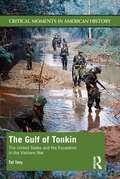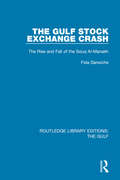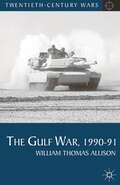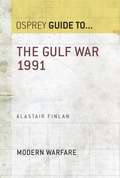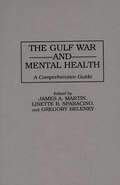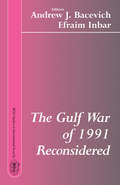- Table View
- List View
Guerrilla Warfare (Penguin Modern Classics)
by Ernesto Che Guevara'Guerrilla warfare is a war of the masses, a war of the people'First published in 1961, following the successful Cuban Revolution, this is Che Guevara's handbook for guerrilla war.It covers strategy, tactics, terrain, organization of an army, logistics, field medical treatment, intelligence, propaganda and training, and focuses on seven 'golden rules' of guerrilla warfare. Widely studied both by insurrectionist movements and those who have tried to suppress them, this is the key text to understand how revolutions can be fought and won by ordinary people.
Guerrilla Warfare: A Historical, Biographical, and Bibliographical Sourcebook
by Anthony J. JoesFrom the Carolina Swamp Fox to the Afghan Mujahideen, this book analyzes 40 guerrilla struggles across five continents, profiles important figures, and gives extensive bibliographical information. With an emphasis on causes and effects, Part I surveys and analyzes all major guerrilla struggles and many less well known wars from the American Revolution to 20th-century post-colonial conflicts. Drawing a distinction between guerrilla warfare and terrorism, the author focuses on guerrilla activity. He seeks to answer such questions as the genesis and context of an insurgency, its resemblance to other guerrilla conflicts, what factors contributed to victory or defeat, which factors are unique to a conflict, and what factors are common to many conflicts.Part II profiles individuals who are important to the subject, including guerrilla chieftains, military commanders, government officials, party leaders, theorists, and instructors who exerted notable influence. Part III surveys the major English-language literature on guerrilla warfare, providing a a wide-ranging, representative, and intensive collection of works.
Guerrilla Warfare: A Historical and Critical Study
by Walter LaqueurAs the author makes clear, every book has a history; Guerrilla Warfare is no exception. Together with its sequel Terrorism (and two companion readers) it was part of a wider study: to give a critical interpretation of guerrilla and terrorism theory and practice throughout history. It did not aim at providing a general theory of political violence, nor did it give instructions on how to conduct guerrilla warfare and terrorist operations. Its aim remains to bring about greater semantic and analytic clarity, and to do so at psychological as well as political levels.While the word guerrilla has been very popular, much less attention has been given to guerrilla warfare than to terrorism - even though the former has been politically more successful. The reasons for the lack of detailed attention are obvious: guerrilla operations take place far from big cities, in the countryside, in remote regions of a nation. In such areas there are no film cameras or recorders.In his probing new introduction, Laqueur points out that a review of strategies and the fate of guerrilla movements during the last two decades show certain common features. Both mainly concerned nationalists fighting for independence either against foreign occupants or against other ethnic groups within their own country. But despite the many attempts, only in two placesAfghanistan and Chechnya were the guerrillas successful.According to Laqueur historical experience demonstrates that guerrilla movements have prevailed over incumbents only in specific conditions. Due to a constellation of factors, ranging from modern means of observation to increase in firepower. The author suggests that we may witness a combination of political warfare, propaganda, guerrilla operations and terrorism. In such cases, this could be a potent strategy for unsponsored revolutionary change. But either as social history or military strategy this work remains a crucial work of our times.
Guerrilla Warfare: A Historical and Critical Study
by Walter LaqueurAs the author makes clear, every book has a history; Guerrilla Warfare is no exception. Together with its sequel Terrorism (and two companion readers) it was part of a wider study: to give a critical interpretation of guerrilla and terrorism theory and practice throughout history. It did not aim at providing a general theory of political violence, nor did it give instructions on how to conduct guerrilla warfare and terrorist operations. Its aim remains to bring about greater semantic and analytic clarity, and to do so at psychological as well as political levels.While the word guerrilla has been very popular, much less attention has been given to guerrilla warfare than to terrorism - even though the former has been politically more successful. The reasons for the lack of detailed attention are obvious: guerrilla operations take place far from big cities, in the countryside, in remote regions of a nation. In such areas there are no film cameras or recorders.In his probing new introduction, Laqueur points out that a review of strategies and the fate of guerrilla movements during the last two decades show certain common features. Both mainly concerned nationalists fighting for independence either against foreign occupants or against other ethnic groups within their own country. But despite the many attempts, only in two placesAfghanistan and Chechnya were the guerrillas successful.According to Laqueur historical experience demonstrates that guerrilla movements have prevailed over incumbents only in specific conditions. Due to a constellation of factors, ranging from modern means of observation to increase in firepower. The author suggests that we may witness a combination of political warfare, propaganda, guerrilla operations and terrorism. In such cases, this could be a potent strategy for unsponsored revolutionary change. But either as social history or military strategy this work remains a crucial work of our times.
Guerrilla Warfare
by 'Yank' Levy1941. Britain is under some of the heaviest air raids of the Second World War. Concerns about Nazi paratroopers landing in Britain and invading take hold in the hearts of the British citizenry. The Home Guard has been mobilised to defend against airborne assault – and it needs training. ‘Yank’ Levy is brought in to Osterley Park to teach guerrilla warfare, from practical experience in the Spanish Civil War. ‘Yank’ trains soldiers of the Home Guard how to use surveillance, defend against tanks and armoured vehicles, how to fight in towns and across country and against a well-supplied, highly-trained and mobile occupying force. His book, Guerrilla Warfare offers such sound advice as: ‘Whether you go to a tea-party or to work on your allotment…take your rifle with you. Don’t leave it downstairs for a German to grab if he enters the house’ and 'Your motto should always be: ‘Finish them! Then a quick get-away, and another ambush some place else’’
Guerrillas in the Jungle (SAS Operation)
by Shaun ClarkeUltimate soldier. Ultimate mission. But will the SAS patrol escape the deadly Malayan jungle alive?
Guidance from the Greatest: What the World War Two generation can teach us about how we live our lives
by Gavin Mortimer'We will overcome it [and] I hope in the years to come, everyone will be able to take pride in how they responded to this challenge, and those who come after us will say the Britons of this generation were as strong as any' Her Majesty The QueenThe Coronavirus pandemic forced the great British people to dig to the very depths of their resolve. It was during this crisis, the gravest crisis the country has faced since the Second World War, that members of the Greatest Generation - Tom Moore, Dame Vera Lynn, the Queen - proved vital reminders of the self-effacing stoicism required in times of emergency; to summon our 'Blitz spirit' and to 'Keep Calm and Carry On'.Taking twelve qualities of the wartime generation, including fellowship, courage and integrity, and drawing on personal interviews with over two hundred Second World War veterans - from SAS officers to London firewomen to Dame Vera herself - Guidance from the Greatest shows us how we can improve our individual character and our collective approach to life.Guidance from the Greatest reminds us of all that is great about Britain and shows how we can build upon that greatness for the future.
A Guide to Films on the Korean War (Bibliographies and Indexes in American History #Vol. 35)
by Paul M. EdwardsWritten by a knowledgeable film critic and Korean War scholar, this is the only guide exclusively devoted to the study of Hollywood and television films based on the Korean War, 1950-1953. It opens with eight short essays, discussing the appeal of the war film genre, government and filmmaker cooperation, the isolation of Korean War films from other war films, why John Wayne didn't make a Korean War film, the other actors who did, the plots of Korean War films, television and Korean War films, and the myths resulting from films. Eighty-four films are then discussed in alphabetically arranged entries.The entries include production unit, color status, producer, director, screenwriter, actors and actresses, movie length, and the author's numerical rating of the film. The commentary places each film within the context of other war films, the Korean War, trends in Hollywood, and the social and political realities of the United States. The films also are listed chronologically. Producers, directors, screenwriters, actors, and actresses are indexed by responsibility and are included in the general index. The book also provides a list of 109 documentary films available for public viewing.
A Guide to the Sources of British Military History (Routledge Library Editions: Military and Naval History)
by Robin HIghamDesigned to fill an overlooked gap, this book, originally published in 1972, provides a single unified introduction to bibliographical sources of British military history. Moreover it includes guidance in a number of fields in which no similar source is available at all, giving information on how to obtain acess to special collections and private archives, and links military history, especially during peacetime, with the development of science and technology.
A Guide to the Sources of British Military History (Routledge Library Editions: Military and Naval History)
by Robin HighamDesigned to fill an overlooked gap, this book, originally published in 1972, provides a single unified introduction to bibliographical sources of British military history. Moreover it includes guidance in a number of fields in which no similar source is available at all, giving information on how to obtain acess to special collections and private archives, and links military history, especially during peacetime, with the development of science and technology.
Guilford Courthouse 1781: Lord Cornwallis's Ruinous Victory (Campaign)
by Adam Hook Angus KonstamBy the Spring of 1781, the American Revolutionary War had dragged on for almost six years and the outcome still hung in the balance. When the British commander Lord Cornwallis launched his invasion of North Carolina in early 1781, his objective was to destroy General Nathaniel Greene's American army. At Guilford Courthouse on 15 March 1781 the two armies met. In a desperately hard-fought battle the small but professional British army succeeded in fighting its way through three separate lines of American troops – but at a dreadful cost. Cornwallis lost over a quarter of his command. When news of the 'victory' reached Britain, a politician remarked; 'Another such victory would ruin the British army'.
Guilford Courthouse 1781: Lord Cornwallis's Ruinous Victory (Campaign #109)
by Angus Konstam Mr Adam HookBy the Spring of 1781, the American Revolutionary War had dragged on for almost six years and the outcome still hung in the balance. When the British commander Lord Cornwallis launched his invasion of North Carolina in early 1781, his objective was to destroy General Nathaniel Greene's American army. At Guilford Courthouse on 15 March 1781 the two armies met. In a desperately hard-fought battle the small but professional British army succeeded in fighting its way through three separate lines of American troops – but at a dreadful cost. Cornwallis lost over a quarter of his command. When news of the 'victory' reached Britain, a politician remarked; 'Another such victory would ruin the British army'.
Guilt: A Force of Cultural Transformation
by Katharina Von Kellenbach Matthias BuschmeierAcross the globe guilt has become a contentious issue in discussions over historical accountability and reparation for past injustices. Guilt has become political, and it assumes a highly visible place in the public sphere and academic debate in fields ranging from cultural memory, to transitional justice, post-colonialism, Africana studies, and the study of populist extremism. This volume argues that guilt is a productive force that helps to balance unequal power dynamics between individuals and groups. Moreover, guilt can also be an ambivalent force affecting social cohesion, moral revolutions, political negotiation, artistic creativity, legal innovation, and other forms of transformations. With chapters bridging the social sciences, law, and humanities, chapter authors examine the role and function of guilt in society and present case studies from seven national contexts. The book approaches guilt as a generative and enduring presence in societies and cultures rather than as an oppressive and destructive burden that necessitates quick release and liberation. It also considers guilt as something that legitimates the future infliction of violence. Finally, it examines the conditions under which guilt promotes transformation, repair, and renewal of relationships.
Guilt: A Force of Cultural Transformation
by Katharina Von Kellenbach Matthias BuschmeierAcross the globe guilt has become a contentious issue in discussions over historical accountability and reparation for past injustices. Guilt has become political, and it assumes a highly visible place in the public sphere and academic debate in fields ranging from cultural memory, to transitional justice, post-colonialism, Africana studies, and the study of populist extremism. This volume argues that guilt is a productive force that helps to balance unequal power dynamics between individuals and groups. Moreover, guilt can also be an ambivalent force affecting social cohesion, moral revolutions, political negotiation, artistic creativity, legal innovation, and other forms of transformations. With chapters bridging the social sciences, law, and humanities, chapter authors examine the role and function of guilt in society and present case studies from seven national contexts. The book approaches guilt as a generative and enduring presence in societies and cultures rather than as an oppressive and destructive burden that necessitates quick release and liberation. It also considers guilt as something that legitimates the future infliction of violence. Finally, it examines the conditions under which guilt promotes transformation, repair, and renewal of relationships.
The Gulag Archipelago
by Aleksandr Solzhenitsyn'[The Gulag Archipelago] helped to bring down an empire. Its importance can hardly be exaggerated' Doris Lessing, Sunday Telegraph WITH A NEW FOREWORD BY JORDAN B. PETERSONA vast canvas of camps, prisons, transit centres and secret police, of informers and spies and interrogators but also of everyday heroism, The Gulag Archipelago is Aleksandr Solzhenitsyn's grand masterwork. Based on the testimony of some 200 survivors, and on the recollection of Solzhenitsyn's own eleven years in labour camps and exile, it chronicles the story of those at the heart of the Soviet Union who opposed Stalin, and for whom the key to survival lay not in hope but in despair.A thoroughly researched document and a feat of literary and imaginative power, this edition of The Gulag Archipelago was abridged into one volume at the author's wish and with his full co-operation. 'Solzhenitsyn’s masterpiece...The Gulag Archipelago helped create the world we live in today' Anne Applebaum THE OFFICIALLY APPROVED ABRIDGEMENT OF THE GULAG ARCHIPELAGO VOLUMES I, II & III
Gulf Military Forces in an Era of Asymmetric Wars [2 volumes]: [2 volumes] (Praeger Security International)
by Khalid Al-Rodhan Anthony H. CordesmanThe significance of the Persian Gulf to international peace and security and to the global energy market cannot be overstated. Events such as the attacks of September 11 and the rise in energy demand and prices have only highlighted the importance of stability in the Gulf to the health of the global economy. This book demonstrates that the nature of military and political threats in the Gulf states (Bahrain, Saudi Arabia, Iran, Iraq, Qatar, Yemen, and the UAE) has shifted during the past three years. Although the threat from Saddam Hussein's Iraq, which produced three recent, major conventional wars-Iran-Iraq (1980-88), Persian Gulf (1990), and Iraq (2003)-has largely disappeared, it has been replaced by concerns over the asymmetric warfare conducted by terrorist organizations and over the proliferation of WMDs by both states and terrorists. These developments are affecting the defense planning and strategic posture of each country, and this book analyzes developments in the force structures of the Gulf states and their ability to deal with this shift in the nature of the threat.The military and security forces of the Gulf states must evolve to adapt to the changing nature of the threat and take into account the risk of the Iraqi insurgency and the uncertainty surrounding Iraq's future. The key areas covered in this book include the internal terrorist threat to Saudi Arabia and the Gulf states; the impact of Iran's nuclear program and the risk it poses to energy and internal security in the Gulf area; and border disputes within the region that could develop into conflict. In addition, the book studies the impact of the Iraq War on regional security and the fear of the insurgency spilling over into neighboring states. Cordesman and Al-Rodhan demonstrate a shift toward using internal security services to deal with the threat of extremism and asymmetric warfare. They also suggest that high energy prices and export revenues provide the Gulf countries the opportunity to upgrade their military forces and deal with their undercapitalization as a result of low oil prices in the 1990s. Moreover, they insist that the future of Iraq, the strategic and nuclear posture of Iran, and the terrorist threat will remain major risks and uncertainties in the short to medium run.
The Gulf of Tonkin: The United States and the Escalation in the Vietnam War (Critical Moments in American History)
by Tal TovyThe Gulf of Tonkin: The United States and the Escalation in the Vietnam War analyzes the events that led to the escalation of the conflict in Vietnam and increased American involvement. On August 4, 1964, the captains of two American destroyers, the USS Maddox and the USS Turner Joy, reported that their ships were being attacked by North Vietnamese torpedo boats. This report came on top of a previous report by the captain of the USS Maddox, indicating that he had been attacked by torpedo boats two nights earlier. The text introduces readers to the historiography of these incidents and how the perception of the events changed over time. The attacks, which were collectively called the Gulf of Tonkin incident, are presented in the context not only of the Vietnam War but also of the Cold War and U.S. government powers, enabling students to understand the events’ full ramifications. Using essential primary documents, Tal Tovy provides an accessible introduction to a vital turning point in U.S. and international affairs. This book will be useful to all students of the Vietnam War, American military history, and foreign policy history.
The Gulf of Tonkin: The United States and the Escalation in the Vietnam War (Critical Moments in American History)
by Tal TovyThe Gulf of Tonkin: The United States and the Escalation in the Vietnam War analyzes the events that led to the escalation of the conflict in Vietnam and increased American involvement. On August 4, 1964, the captains of two American destroyers, the USS Maddox and the USS Turner Joy, reported that their ships were being attacked by North Vietnamese torpedo boats. This report came on top of a previous report by the captain of the USS Maddox, indicating that he had been attacked by torpedo boats two nights earlier. The text introduces readers to the historiography of these incidents and how the perception of the events changed over time. The attacks, which were collectively called the Gulf of Tonkin incident, are presented in the context not only of the Vietnam War but also of the Cold War and U.S. government powers, enabling students to understand the events’ full ramifications. Using essential primary documents, Tal Tovy provides an accessible introduction to a vital turning point in U.S. and international affairs. This book will be useful to all students of the Vietnam War, American military history, and foreign policy history.
The Gulf Stock Exchange Crash: The Rise and Fall of the Souq Al-Manakh
by Fida DarwicheThe collapse of Souq Al-Manakh in Kuwait in August 1982 was the most spectacular financial crash of recent years. The market had developed as a parallel stock exchange dealing in the shares of Gulf companies not resident in Kuwait. Fuelled by manic speculation, the market grew at a phenomenal rate throughout 1981 and early 1982. Inexperienced investors gambled huge sums on the shares of shell companies promoted largely for share speculation. At the height of the market US$92 billion was outstanding on nearly 30,000 postdated cheques, the usual form of payment used in the market. The financial crisis created by the collapse of the Souq Al-Manakh threatened the stability of Kuwait. The government was forced to intervene and absorb the major part of the loss. This book, first published in 1986, traces the growth of the stock market and analyses its collapse. It also discusses in detail the wider impact of this debacle on the economic life of the Gulf.
The Gulf Stock Exchange Crash: The Rise and Fall of the Souq Al-Manakh
by Fida DarwicheThe collapse of Souq Al-Manakh in Kuwait in August 1982 was the most spectacular financial crash of recent years. The market had developed as a parallel stock exchange dealing in the shares of Gulf companies not resident in Kuwait. Fuelled by manic speculation, the market grew at a phenomenal rate throughout 1981 and early 1982. Inexperienced investors gambled huge sums on the shares of shell companies promoted largely for share speculation. At the height of the market US$92 billion was outstanding on nearly 30,000 postdated cheques, the usual form of payment used in the market. The financial crisis created by the collapse of the Souq Al-Manakh threatened the stability of Kuwait. The government was forced to intervene and absorb the major part of the loss. This book, first published in 1986, traces the growth of the stock market and analyses its collapse. It also discusses in detail the wider impact of this debacle on the economic life of the Gulf.
The Gulf War, 1990-91 (Twentieth Century Wars)
by William Thomas AllisonIn August 1990, Saddam Hussein's Iraqi forces boldly invaded and occupied neighboring Kuwait. It was a move that shocked the world and threatened the interests of those countries, such as the USA and the nations of Europe, dependent on oil from the Middle East. The ensuing Gulf War signaled, for many, a new dawn in warfare: one based upon lethal technology, low casualties, and quick decisive victory.Incorporating the latest scholarship, William Thomas Allison provides a concise overview of the origins, key events and legacy of the first Gulf War, as well as the major issues and debates. Allison also examines the relevance of this war to other twentieth-century conflicts and the ongoing situation in the region.
The Gulf War 1991 (Guide to...)
by Professor Alastair FinlanThe Gulf War of 1991 heralded a new type of warfare that was characterised by astonishing speed and high technology with remarkably low numbers of casualties amongst the coalition forces. Just under a million coalition personnel were deployed to the Gulf region to face a variety of threats from extreme temperatures to weapons of mass destruction (biological, chemical and suspected nuclear) and a formidable Iraqi occupation force. This book assesses the defensive Operation Desert Shield (the build up of coalition forces) and the offensive Operation Desert Storm (the liberation of Kuwait) as well as the key personalities on both sides.
The Gulf War and Mental Health: A Comprehensive Guide
by G L Belenky James Martin Linette SparacinoThe brief, successful Gulf War resulted in few casualties, but there were still recognizable pockets of trauma. This study examines the Mental Health Services available in the theater of operations, the preparations made to train the soldiers for the stress of combat, and details of how they coped with the experience of combat. It assesses the Gulf War in terms of mental health. Some attention is also given to the phenomenon named Gulf War Syndrome. The authors conclude that United States Military Forces were not prepared for the mental health requirements of combat.
The Gulf War of 1991 Reconsidered (Besa Studies In International Security)
by Andrew J. Bacevich Efraim InbarThe Gulf War of 1991 Reconsidered subjects one of the formative events of the post-Cold War era and a watershed in Middle Eastern international politics to a comprehensive reassessment. Condidering events from Arab, Israeli and American view points, the book examines the Gulf War's historical origins, conduct and legacy.
The Gulf War of 1991 Reconsidered
by Andrew J. Bacevich Efraim InbarThe Gulf War of 1991 Reconsidered subjects one of the formative events of the post-Cold War era and a watershed in Middle Eastern international politics to a comprehensive reassessment. Condidering events from Arab, Israeli and American view points, the book examines the Gulf War's historical origins, conduct and legacy.
